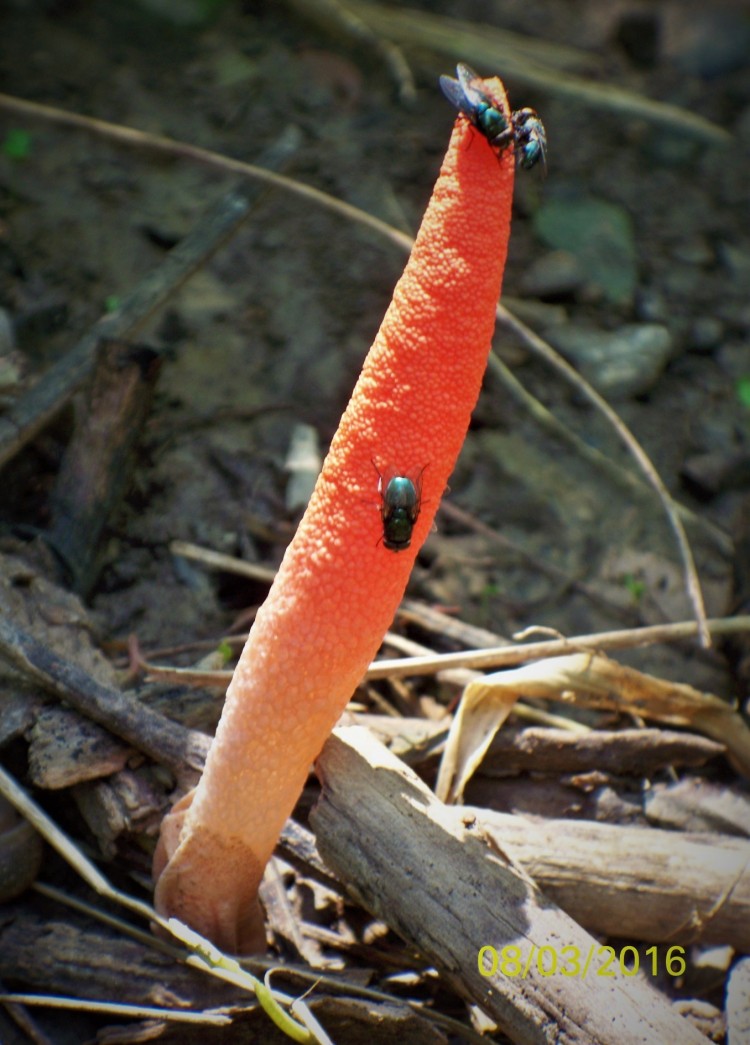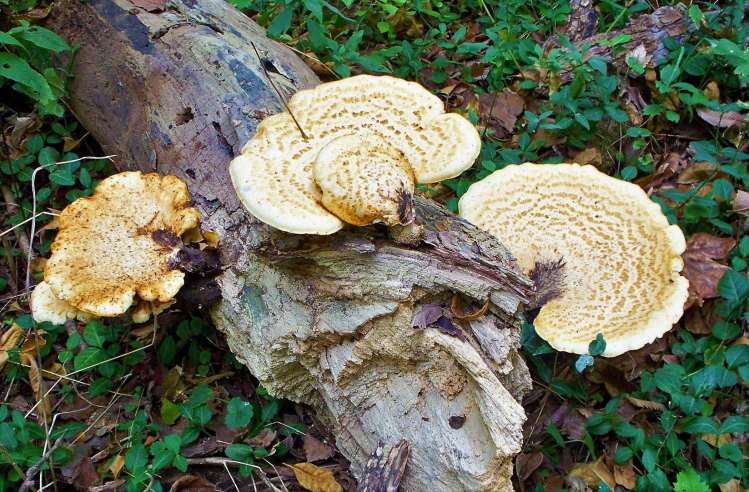
- this velvety red fungus has yet to be ID’ed
Though winter woods are beautiful and so revealing, by this time of year I am longing for more color. Not just the green of madly photosynthesizing leaves, but the rarer hues.
In our forest the brightest pigments pop up unexpectedly – in the fruiting bodies of fungi. I never hunt for fungi, but find them in the course of doing something else. Another one of the perks of being off-trail a lot cutting or pulling invasive plants.
But what is the purpose of fungal pigments? Very few fungi need to attract the services of insects, since they don’t engage in cross pollination. One group that does advertise are the stinkhorns. With the color of flesh and smell of rotting meat, plus a coating of nasty brown slime called the “gleba”, there is no doubt who the customers are. Flies walk on and eat the spore containing slime, then act as dispersers.

- though young and fresh, this Mutinus caninus is already attracting flies
It’s harder to understand why the color pink would be needed by the life form pictured below, part of a kingdom so ancient that it predates insects.

If you did a search by typing in “fungus that looks like bubble gum” you’d get a lot of pictures of this. Except that it isn’t a fungus at all, it’s the bubble gum slime mold in its spore-producing stage. This one is a cosmopolitan species, meaning you can spot it in South Africa, Scotland and Alaska. I was lucky enough to spot it on a rotten log in our forest.
Not even close to fungi, slime molds have their own kingdom, the Protoctista. A slime mold you may have seen is the equally descriptively named “dog vomit slime mold”, its neon yellow plasmodium often creeping over front yard mulch in search of food. The sporangia stage that it changes into overnight is not nearly so attractive, hence the name.

- Leucocoprinus birnbuamii
According to my internet search, this vivid mushroom is most likely to pop up in a flowerpot or a green house, though I photographed it in our forest. The “yellow houseplant mushroom” as it’s called in North America, could be considered an invasive species since it has traveled out of the tropics with the help of humans.

- cut honeysuckle limb turned over to expose Terana caerulea,
Back to the question of colors – how does science explain the shockingly bright hue of the cobalt crust fungus? (It really defines the color “cobalt blue”- the first time I saw one, was sure that someone had been busy with a can of spray paint!)
The cobalt crust, also described as “blue velvet on a stick” is relatively common in our forest. It shelters on the underside of dead limbs, enjoying the wealth of new habitat found on cut bush honeysuckle. And the blue pigment is much more than color – it’s a biochemical weapon and defense system, particularly against bacteria. Since this fungus occurs in Europe too, it has been well studied, and the antibiotic cortalcerone is made from it. In fact, bacteria also use pigments in this fashion and can be disabled in the lab by having their colors removed.
These pigments are found throughout living systems, another example of our close relatedness with all life. Melanin, which shelters us from ultraviolet radiation, is found in fungi too – researchers refer to it as “fungal armor”
So when you next see a shockingly colorful mushroom – ruminate on the wealth and potency of the biochemical compounds we call pigments. And isn’t it humbling to realize how much we share with fungus?

judy
Very interesting. I will be on the look out for the friendly (and not so friendly) fungus.
Thanks Rosemary!
Judy
LikeLike